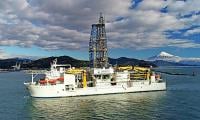‘Proposed coal power plants at Port Qasim would add to pollution levels’
Environmentalists, engineers, lawmakers and citizens express concerns over health problems and sea pollution caused by two 350MW coal power plants
Environmentalists, engineers, lawmakers and concerned citizens at a public hearing on Thursday objected to allowing the construction of coal power plants at Port Qasim in Karachi that would cause health problems for the area’s population and sea pollution because of their carbon emissions and hazardous gases.
They urged the Sindh Environmental Protection Agency (Sepa) to put strict regulations in place for environmental safety.
At the public hearing of the environmental impact assessment (EIA) of two 350MW coal power plants, organised by Sepa at a hotel in Karachi, the participants deplored that nuclear power plants were being built near Hawkesbay on one side of the city and on the other, coal power plants were being set up endangering the already deteriorating environment of the city.
They noted that the power plants would further worsen air quality and pollute the sea where marine life is already diminishing because of pollution and the dumping of hazardous industrial and domestic effluent.
The public hearing was presided over by Sepa DG Naeem Ahmed Mughal and moderated by Tech Deputy Director Imran Sabir.
Datang Pakistan CEO Liu Yong Jun and K-Electric project director Emran Ahmed Khan were also present there.
EMC project director Nadeem Arif, EIA study team leader Saquib Ejaz Hussain and former PCSIR director general Dr Mirza Arshad Ali Beg presented the findings of the study.
The proponent of the coal power project is Datang Pakistan Karachi Power Generation (Private) Limited, which is constructing a coal-fired power stations on 216 acres in the Eastern Industrial Zone of the Port Qasim Authority.
Pakistan Tehreek-e-Insaf MNA Arif Alvi highlighted the issues of coal dust and carbon emissions from the chimneys of the coal power plants, saying their installation would further deteriorate the environmental conditions and jeopardise the lives of the citizens of Karachi, especially the fisherfolk living along the coast as they depended on the sea for their livelihood.
“Carbon dioxide and emissions of other hazardous gases from the coal power plants, other mega industries and the burning of fossil fuel both at the industrial and domestic levels would be a major challenge for Pakistan in the near future,” he observed.
“Pakistan is among worst affected countries due to climate change but it should not be a contributor to it,” Alvi added.
He advised Sepa to strictly monitor the performance the coal power plants, especially the handling of the coal at the port and carbon emissions. He added that all proponents including Datang Pakistan should take notice of these issues and take measures to combat climate change.
Pervaiz Sadiq, a member of the Institution of Engineers Pakistan, said Sepa should bind the proponent of the project to continuously monitor the plants and regularly submit reports.
Moin Uddin Ali Khan from the Institute of Business Management appreciated the “Cash the Ash” slogan and said ash recycling applications and market were not developed in Pakistan, so the Datang Pakistan management should consult with cement factories and other construction industries for proper utilisation of ash.
He further said research and development on ash management was needed and for that the Datang Pakistan should collaborate with the research institutions in Pakistan.
Shams Ul Haq Memon, former environment secretary, highlighted the importance of mangroves and requested Sepa to put in place conditions for their re-plantation at a rate of 1: 5. He also advised Sepa to formulate regulations on the utilisation of coal ash.
Sepa director general Naeem Ahmed Mughal told the participants of the hearing that coal power projects would now be examined in the context of climate change. “Sepa will ensure the compliance of the Sindh Environmental Protection Act 2014 and will take every step to control pollution in Sindh”.
He said the EIA conducted by the proponent’s environmental consultant was excellent on paper but expressed concern that in practice “good environmental practices” were hardly followed and vowed to keep a close eye on the project during its construction and completion as well as functional phases to ensure environmental laws of the province are not flouted.
Emran Ahmed Khan, the K-Electric project director, said the project aimed at the installation of two 350 MW coal-based supercritical thermal power plants to reduce the dependency on expensive high sulphur fuel oil and to introduce cheaper fuel for power generation, increase the efficiency and provide reliable low cost power to Karachi.
“The proposed coal power plants will adopt supercritical boiler technology,” he added.
He explained that the major systems of the power project included a coal jetty, a super-critical boiler, a pulverised coal generation plant, a coal storage area surrounded by wind shield, coal handling covered conveyors, water supply and waste water systems, a ash handling system, an emission control system, a flue gas desulfurisation system, dust prevention,, and fire monitoring and prevention facilities.
The plants’ design is based on using imported coal with the capability to burn local coal in the future. To satisfy the fuel requirements of the proposed coal-fired power plant, approximately, 2.5 million tons per annum coal will be imported from Indonesia, South Africa or Australia, with an expected calorific value of 20.14 MJ/kg and brought to the plant via Panamax-type shipping vessels. These vessels will unload coal at a dedicated coal jetty at the southern edge of the proposed plant. The ash content is expected to be 8-14 percent. The expected sulfur content is less than one percent
Saquib Ejaz Hussain, the EIA team leader, said the emissions from the plant would be dispersed at the designed height of 220 meters. The 220m tall stack heights with high momentum and buoyancy takes the plume above the highest mixing height. The values of the emissions at the fallout distance would be within the Sindh Environmental Quality Standards.
“The value of PM10 and PM2.5 which is the parameter of concern in the coal-fired power plants is much within the limits suggested by SEQS. As such, the introduction of mitigation measures will entail emissions that will be within all standards and guidelines,” he added.
For all criteria pollutants, including SO2 & NOx, the inclusion of appropriate flue gas cleaning systems will meet all current requirements reliably and economically. These systems use well-proven technology such as ESPs for fine particulates removal, FGD for SO2 control, together with combustion modifications (low-NOx burners) for control of NOx. Each boiler is equipped with electrostatic precipitators with a dust removal efficiency of at least 99.7 percent so as to achieve a dust concentration of less than 50mg/Nm3 at chimney outlet.
The efficient ash management system adopted for the proposed power plants will control the release of ash as well as heavy metal into environment. Ash generated during project operation will be ultimately sold to cement plants.
The use of fly ash as building material allows energy savings and the reduction of CO2 emissions as one ton of fly ash replacing cement saves one ton of CO2. There are a number of potential users of ash produced by the project in the vicinity of the Datang Pakistan. These include cement plants located at a distance of 100-150kms from the plant mostly on the main highway M-9 linking Hyderabad to Karachi. Production of cement concrete blocks where bottom ash can be used as an aggregate is also common and widespread in Karachi.
Datang Pakistan Karachi Power Generation (Private) Limited is an entity incorporated under the Companies Ordinance, 1984 to act as a special purpose vehicle and develop two 350 MW imported coal power plants at Port Qasim Karachi, sponsored by China Datang Overseas Investment Co Ltd, China Machinery Engineering Corporation and K-Electric Limited.
-
 Jason Momoa Cherishes Hosting Ozzy Osbourne's Final Gig Ahead Of His Death
Jason Momoa Cherishes Hosting Ozzy Osbourne's Final Gig Ahead Of His Death -
 Real Reason Timothee Chalamet Thanked Kylie Jenner At Awards Revealed
Real Reason Timothee Chalamet Thanked Kylie Jenner At Awards Revealed -
 Will King Charles Attend Funeral Of Prince Philip's First Cousin, Princess Irene?
Will King Charles Attend Funeral Of Prince Philip's First Cousin, Princess Irene? -
 'Furious' Prince William Wants Andrew As Far Away As Possible
'Furious' Prince William Wants Andrew As Far Away As Possible -
 Blood Moon: When And Where To Watch In 2026
Blood Moon: When And Where To Watch In 2026 -
 Apple Foldable IPhone Tipped For 2026 Launch With A20 Pro Chip And C2 Modem
Apple Foldable IPhone Tipped For 2026 Launch With A20 Pro Chip And C2 Modem -
 Meghan Lends Credence To Reports Of Rift With Kim Kardashian On Chicago's Birthday
Meghan Lends Credence To Reports Of Rift With Kim Kardashian On Chicago's Birthday -
 Florida Woman’s Alleged Bid To Bribe Police Ends In Unexpected Discovery
Florida Woman’s Alleged Bid To Bribe Police Ends In Unexpected Discovery -
 James Van Der Beek Strongly Opposes The Idea Of New Year In Winter
James Van Der Beek Strongly Opposes The Idea Of New Year In Winter -
 Elon Musk’s Starlink Rival Eutelsat Partners With MaiaSpace For Satellite Launches
Elon Musk’s Starlink Rival Eutelsat Partners With MaiaSpace For Satellite Launches -
 Fans Feel For Leonardo DiCaprio As He Gets Awkwardly Snubbed: Watch
Fans Feel For Leonardo DiCaprio As He Gets Awkwardly Snubbed: Watch -
 Japan Launches The World’s First Trial To Extract Rare Earth Elements
Japan Launches The World’s First Trial To Extract Rare Earth Elements -
 Prince Harry Breaks Cover In California Amid Tension At Home With Meghan Markle
Prince Harry Breaks Cover In California Amid Tension At Home With Meghan Markle -
 ASAP Rocky Makes Massive Comeback With New Album
ASAP Rocky Makes Massive Comeback With New Album -
 Amanda Seyfried Unveils How Channing Tatum Teased Her On 'Dear John' Set
Amanda Seyfried Unveils How Channing Tatum Teased Her On 'Dear John' Set -
 Blue Moon 2026: Everything You Need To Know
Blue Moon 2026: Everything You Need To Know



